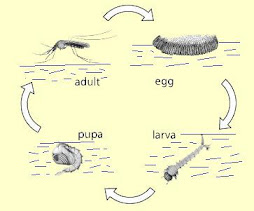http://www.mosquitoes.org/LifeCycle.html
A mosquito may lay a raft of eggs every third night during its life span. Tiny mosquito larvae emerge from a raft of from 200- 300 eggs eggs within 24 hours.
Notes: Anopheles mosquitoes lay their eggs singly on the water, not in rafts. Aedes mosquitoes lay their eggs singly on damp soil. Aedes eggs hatch only when flooded with water (salt water high tides, irrigated pastures, treeholes, flooded stream bottoms, etc.).
Mosquito larvae must live in water from 7 to 14 days depending on water temperature. Larvae must come to the surface at frequent intervals to obtain oxygen through a breathing tube called a siphon. The larva eats algae and small organisms which live in the water. During growth, the larva molts (sheds its skin) four times.before it becomes a pupa.
Note : Anopheles are unlike Culex and Aedes larvae since they do not have a breathing tube, they must lie parallel to the water surface in order to get a supply of oxygen through a breathing opening.
Mosquito pupae must live in water from 1 to 4 days, depending upon species and temperature.The pupa is lighter than water and therefore floats at the surface. It takes oxygen through two breathing tubes called "trumpets". When it is disturbed it dives in a jerking, tumbling motion and then floats back to the surface. The pupa does not eat. The metamorphosis of the mosquito into an adult is completed within the pupal case.The adult mosquito splits the pupal case and emerges to the surface of the water where it rests until its body can dry and harden.
Only female mosquitoes bite animals and drink blood. Male mosquitoes do not bite, but feed on the nectar of flowers.
Aedes mosquitoes are painful and persistent biters, attacking during daylight hours (not at night). Aedes mosquitoes are strong fliers and are known to fly many miles from their breeding sources.
Culex mosquitoes are painful and persistent biters also, but prefer to attack at dusk and after dark, and readily enter dwellings for blood meals. Domestic and wild birds are preferred over man, cows, and horses. Culex tarsalis is known to transmit encephalitis (sleeping sickness) to man and horses. Culex are generally weak fliers and do not move far from home, although they have been known to fly up to two miles. Culex usually live only a few weeks during the warm summer months. Those females which emerge in late summer search for sheltered areas where they "hibernate" until spring. Warm weather brings her out in search of water on which to lay her eggs.
Culiseta mosquitoes are moderately aggressive biters, attacking in the evening hours or in shade during the day.
Anopheles mosquitoes are the only mosquito which transmits malaria to man.
The average life span of a female mosquito is 3 to 100 days. the male lives 10 to 20 days. One female mosquito may lay 100 to 300 eggs at a time and may average 1,000 to 3,000 offsprings during her life span. http://control-mosquitoes.com/#mf6
mosquito control

Importance of water surface during egg-larva-pupa stages
Subscribe to:
Post Comments (Atom)
No comments:
Post a Comment